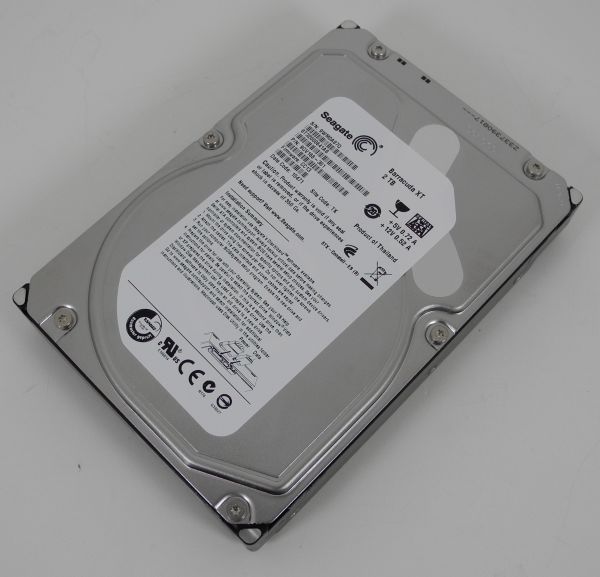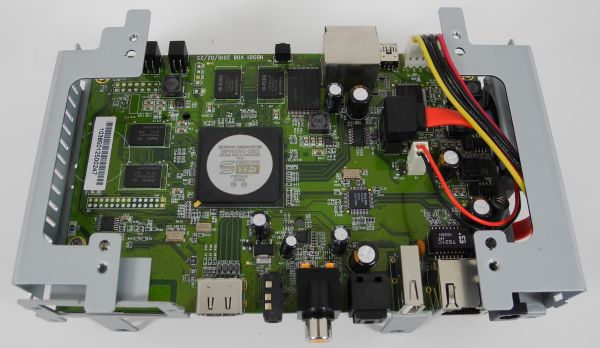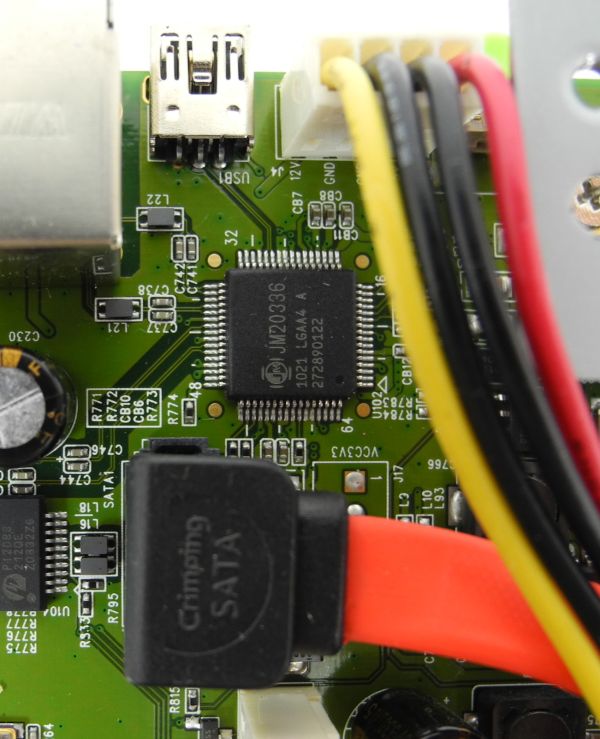Nixeus Fusion HD Review
by Ganesh T S on March 4, 2011 3:26 PM EST- Posted in
- Home Theater
- Media Streamer
- Gadgets
In order to install an internal hard disk, it is necessary to remove the top cover of the Fusion HD. For our review, we used a 2 TB Barracuda XT 7200 rpm provided to us by Seagate.
The top can be taken off by removing 4 screws from the two sides of the Fusion HD, and slightly tugging at one of the sides.
The screws to hold the hard disk in place are provided in the Fusion HD package. The SATA data and power cables make an appearance on the top, and have to be connected to the hard disk properly before being screwed in. Compared to the easy slide in process used by other manufacturers like TViX and A.C.Ryan, this method of installation is a bit clunky, and not really user friendly (Well, it may be OK for the average AnandTech reader). If you are planning to gift this to someone with a hard disk already installed, it shouldn't be much of an issue.
To get to the system board, the rubber bushes at the base of the unit had to be prised off, as shown in the gallery above. The board is placed in the chassis in an interesting manner. With the hard disk on top, the main components of the board are on the underside. You can see the SATA data and the power cables making its way to the top in the flipped board below.
Click to Enlarge
The main components on the board are as below. There are two sets of DRAM modules for a total of 384 MB of DDR2 DRAM.
- Sigma Designs SMP8655AD Media Processor
- 2 x Hynix HY5PS1G1631C x16 DDR2 DRAM Modules (Total : 2 x 1Gb = 256 MB)
- 2 x Deutron MIRA P3R12ErJFF x16 DDR2 DRAM Modules (Total : 2 x 512Mb = 128 MB)
- Hynix HY27UF081G2A 1Gb (128 MB) NAND Flash
- JMicron JM20336 SATA / USB 2.0 to SATA Bridge
The JMicron chip lies between the SATA data and power cable connectors on the board.
The JM20336 is responsible for the eSATA client / USB 2.0 slave interface on the Fusion HD. It acts as a bridge with SATA at one end and another SATA and USB 2.0 port at the other end. The SMP8655 has 2 SATA II ports. One of them is connected to the internal hard disk, and the other end is connected to the JM20336. When the Fusion HD is connected to a USB 2.0 host or eSATA port, it goes into 'eSATA or USB Client Mode'. No media playback is possible in this mode, as the SMP 8655 is busy routing traffic from the JM20336 through its first SATA port onto the second SATA port.
















31 Comments
View All Comments
SlyNine - Saturday, March 5, 2011 - link
Thanks.I've read that Ciniava is part of the Sigma chips features. What I wasn't aware of is if it's something the OEM can turn on or off. I'm also worried that some firmware update could activate it. You know how the MPAA and RIAA types are with pushing there DRM on people.
Also correct me if I'm wrong please, but AACS is the protection of the content on the disk and it's unlocked/decrypted before it ever gets encrypted in HDCP, so I guess there is no risk of it being implemented on the HDCP/HDMI end (TV's AVR's) Does this sound correct?
ganeshts - Saturday, March 5, 2011 - link
Currently, Cinavia can be implemented on some of the Sigma processors, but not on the 865x ones because they are not meant for Blu-Ray playback.There will be no firmware update for this or the WDTV Live whch can enable Cinavia. On this one, I am pretty confident.
Currently, only BDA (Blu Ray alliance) requires Cinavia, and the player detects the watermark, checks if the file being played back is protected by AACS, i.e, it is from a protected disc, not a bootleg copy or a copy made after removing the AACS using AnyDVD or other similar software, and then allows the media to be played back. Cinavia doesn't extend beyond the actual Blu-Ray / media player.
However, this doesn't discount the fact that in the future there might be AV receivers which, when being used for HD audio bitstreaming, might implement a similar sort of muting or stopping of HD audio decode if the audio is not coming over HDCP. Currently, this is NOT happening, and this is admittedly a far-fetched scenario, but it is not implausible.
Chillin1248 - Friday, March 4, 2011 - link
Can you review the Argosy HV335T 2TB in the near future?I have purchased four such units (actually 3, and one wireless version), and they function amazingly well for their price point, $170. Has a 1073DD chipset and a Samsung 2TB 2040UI HDD.
====
http://www.argosyusa.com/hv335t.shtml?DefaultTab=0
"A perfect companion in your home theater setup, HV335T can play contents from internal HDD (optional), USB HDD/flash drive, or stream contents from another server in your home network. The player also supports uPNP and can work seamless with DMS (Digital Media Server). With DMS software running on a PC, such as PlayOn, HV335T can display internet video/audio supported by DMS directly on the TV. Selected internet services (Picasa, Flickr, Weather, Youtube, Last.FM, MediaFly, Internet TV, Internet Radio, etc) are also available directly.
Audio video output include Composite A/Vand Component output, HDMI output, and Optical digital output. HDMI output support up to 1080p resolution. HV335T supports Dolby Digital and DTS downmixing as well as digital pass through.
Managing the contents on the inernal HDD can be done either with direct USB connection to a PC or over the SAMBA networking connection. The UI also allow copying from USB drives and SAMBA servers to internal HDD or deletion from internal HDD."
====
The reason I bring it up is since they are very supportive of the product (constant firmware updates with new features) and are very responsive to support emails; I wish to see such a company succeed.
Discombobulated28 - Monday, March 28, 2011 - link
Ganesh recently reviewed a RealTek 1283 based media player here:http://www.anandtech.com/show/4212/tvix-slim-s1-bi...
Which performs similar to the RealTek 1073DD chipset, but the RealTek 1283 has a bit more features... from my experience with RealTek media players they almost have similar GUI and similar features or shortcomings due to RealTek's SDKs... with the exceptions of good known brands such as AC Ryan whom are known for better support/quality...
Schugy - Sunday, March 6, 2011 - link
Would also have wiped out most limitations.hohowan - Monday, March 7, 2011 - link
Bug # 11 on the list is and continues to be, the deal breaker for me for any streamer on the market.(ASS subs (stylized and karaoke effects) are not supported properly.)
It is frustrating that no one seems to be able to do these subtitles as well as a standalone PC.
I've pretty up given up hope for a streaming device that works correctly with these kind of subtitles.
I guess I'm going to continue with a spare PC hooked up to the TV for *proper* playback.
ganeshts - Monday, March 7, 2011 - link
Have you tried Boxee Box? With the latest firmware, all the ASS samples I have seem to play OK (with karaoke effects)CrapONez - Thursday, March 10, 2011 - link
I own the Viewsonic NexTV VMP75. It has the same interface and remote as this, without the built-in USB dongle, HD bay, or bittorrent, but it does have Netflix. I've got an external HD hooked up to it with eSata for local playback. Do me a favor and get your hands on one so that Viewsonic addresses some of your bug reports and gives me a firmware update?!?ganeshts - Sunday, March 13, 2011 - link
Would definitely like that, but the problem is that the big companies don't pay attention to our bug reports, while the startups like Nixeus pay more attention.If you take a look at TViX Slim S1, we reported a big set of bugs, but not all of them were resolved.
Destiny - Saturday, March 12, 2011 - link
We finally have a test suite/bench mark/ something concrete to compare media players...HQV 2.0 serves what testing purposes for SoCs and Media Players?